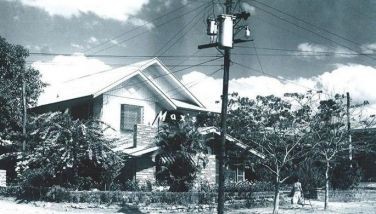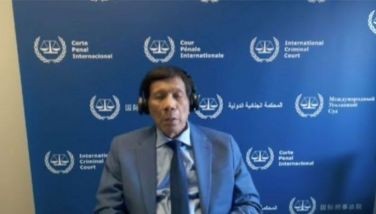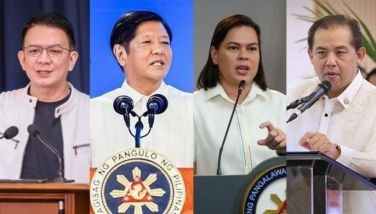Spain in the Philippines
By Ambassador Luis Arias Romero
Speech delivered before Filipino and visiting Spanish journalists in a press forum held July 8-9 at Instituto Cervantes. (Translated from the original Spanish by Rosalinda L. Orosa)
Before I begin, I would like to reiterate my welcome and my enormous satisfaction with your participation in these sessions, and my gratitude to the Press Association of Cadiz and the Latin Union for having organized and sponsored this magnificent undertaking, jointly with the Instituto Cervantes and the Spanish embassy.
Possibly, before the start of this forum, someone will have asked: What can Spanish journalists discuss with their Filipino peers? For what end did they traverse 16 thousand kilometers to discuss issues on means of communication, freedom of the press, etc.? These questions are related to one I am often asked: What remains in the Philippines of Spain and its culture? Or in negative terms, why does nothing remain?
All these queries imply an error that has become a common topic: That Spain, despite its political presence here for more than three centuries, has hardly wielded its cultural influence on the Philippines.
I hope you have had the opportunity to verify that this is not true.
In this country, there are nearly 90 million Catholics who have not surfaced from nothing. Religion, besides being a question of faith, is a cultural fact of the first order which has deeply instilled in the individual, in the family, a definitive way of confronting life. Thus, the first answer, and the simplest, to the doubts regarding what remains of Spain in the Philippines, would be the 90 million Catholics with their own distinctive manner of acting and thinking which indubitably renders the Philippines notably unique in the Far East.
In linguistic terms, with regard to the presence of Spanish in the archipelago, one must remember that the moment Spain left this country, 15 percent of the population expressed itself in Spanish. This percentage is identical to that in Ibero-American countries which declared their independence nearly a century earlier.
Why then does Spanish survive as the official language in Ibero-America, while it has only a token presence here? Quite simply because while people in Peru, Chile, Guatemala, or Mexico find Spanish necessary for communication, people here do not; neither do their neighbors in Indonesia, Malaysia or China.
Despite everything, Spanish survived, and in brilliant form. Besides the national anthem which was originally in Spanish, and was not translated until 1945, many of the pages in Philippine literature are written in Spanish, starting with the great novel by the national hero Jose Rizal, the Noli Me Tangere.
Focusing on journalism, and as Director Jose Rodriguez mentioned at the opening of this session, the periodicals of the activists were in Spanish; e.g. La Solidaridad of Graciano Lopez Jaena, Rizal, Marcelo del Pilar, Antonio Luna, among others; La Libertad of Clemente Zulueta, La Independencia of Antonio Luna and Fernando Ma. Guerrero, or El Heraldo de la Revolucion.
From the time Spain definitely left the Philippines up to 1945, the periodicals in Spanish continued to exist in notable form, and often, were superior to those in English; e.g. El Renacimiento, El Debate, La Voz de Manila, La Vanguardia and others which survived until the 70s, like the weekly Cronica de Manila.
The prevalence of Spanish was not limited to literature, journalism or to the living rooms of the elite. The laws of the Supreme Court were written in Spanish until the start of the 70s; the Senate debates, until the 50s and the start of the 60s, were in Spanish.
Further, until the early years of the 60s, certain Filipino representatives in the UN defended the Philippine position in Spanish, as did DFA Secretary Narciso Ramos in his vigorous defense of the Philippine position regarding Sabah.
Coming to the present, the Instituto Cervantes in Manila, the first to be established in Asia among three of the total 77 existing, has the greatest number of students.
At present, in the homogenized national language called Pilipino, there are more than 22,000 words in Spanish or recognizably derived from Spanish.
Finally, we have to recognize a historical fact, although this is almost unnoticed by media in Spain, that there is a move by the Philippine government to re-introduce Spanish in the secondary schools, with the ultimate aim to teach it to university students and professionals.
After the enumeration of this perfectly irrefutable data, please understand that there is no affirmation whatsoever that Spain’s influence over the Philippines has been negligible.
In bilateral relations, the Philippines figures in the three final Asian Plans which, as you know, constitute the basis of our foreign relations in this continent, and is the country of maximum priority to us.
This is not mere rhetoric. Apart from the quantitative and qualitative presence of the Embassy and the Consulate General in Manila, their affiliates and the Economic Office, as also the Instituto Cervantes, our country is the first in Europe, and in the cooperative development of the Philippines, the fourth in the world in this land.
Being here, we realize that these sessions are not only fully justified but also necessary. The physical distance between Spain and the Philippines and the superficial knowledge at times of many realities which unite us, make this inter-change among professional agents of information imperative.
The Philippines, which in 1945 became the first democracy in Asia, has known and exercised freedom of expression for the last 30 years of the 20th century, excepting the years 1942 to 1945 (the Japanese Occupation) and the authoritarian rule from 1972 to 1986.
The role of the press in the fight for political liberties harks back to 1889 with the appearance of La Solidaridad in Barcelona. Included in the aforementioned newspapers, which led to exceptional and enchanting conditions in the mediums of information, were the clandestine and heroic labors of many Filipino journalists who enormously contributed, especially from 1872 to 1986, to the restoration of democracy, and later, to the correction and denunciation of political conduct which could have deteriorated once more.
In Spain, we have lived in similar situations, and unfortunately, of longer duration. I am thoroughly convinced that now, as we end these encounters, both the Filipino and Spanish participants have come to know a little more about each other, and I hope, at the same time, have established links and agreed on proposed work projects or simply made contacts that will lead to smooth collaboration and mutual understanding relevant to our common past and the many affinities that unite us.
- Latest
- Trending





























